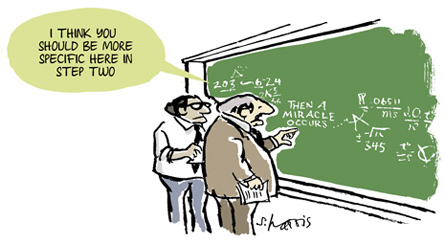You can get there by: Hyperphysics website -> Mechanics -> Conservation of angular momentum -> Angular momentum
If the wheel is rotating about the Z axis, then each little point particle on the wheel has a different radius and a different velocity in the X-Y plane. If you sum them, they would all add to zero (linear velocity, and linear momentum) and hence the need for Angular Momentum. The axis of rotation (Z axis in this case) is chosen for the angular momentum so a single number and a single direction can be used to define the motion.
If the wheel is rotating in the X-Y plane, the angular acceleration vector, angular velocity vector, and angular momentum vector will be perpendicular to that plane, along the Z axis in this case. The right hand rule is used to determine whether it is pointing toward the positive Z or negative Z direction.
If you look at MrV's post from here:
http://www.besslerwheel.com/forum/viewt ... 509#143509
you are looking at the X-Y plane. You can see that when a disk rotates CCW, the angular momentum is positive (positive Z in this case - out of the screen), and when a disk rotates CW, the angular momentum is negative (negative Z in this case - into the screen).
~~~~~~~~~~~~~~~~~~~~~~~~~~~~~~~~~~~~~~~~~~~~~
If you look at the wikipedia link for angular momentum in 3 dimentions:
https://en.wikipedia.org/wiki/Angular_m ... dimensions
you can see that the angular momentum vector "L" is perpendicular to the plane of motion.
If you assume that the ball on the end of the rod is travelling in the X-Y plane, then the light green vector "L" is along the Z axis. You can use the right hand rule and see that when the ball is rotating CCW, the "L" is along the positive Z axis, and when the ball is rotationg CW, the "L" is pointing toward the negative Z axis.
~~~~~~~~~~~~~~~~~~~~~~~~~~~~~~~~~~~~~~~~~~~~~~~~~
Angular momentum is a 3D vector, but sometimes the vector notion is dropped to make it simpler to understand or explain. Or maybe it depends on the problem? If you have a uniform disk spinning, it has angular momentum about the axis of rotation, but if you have a mass moving along some trajectory and you choose an arbitrary reference point, you can have angular momentum about that arbitrary reference point.
Vector, pseudo vector - It's all a mathematical concept invented by mankind. You have this wheel spinning about an axis, and you have to come up with a way to describe it mathematically. Since the individual velocities and momentums all sum to zero (linear), man invented angular velocity and angular momentum as a mathematical tool to describe the motion. It was maybe arbitrary, but also somewhat logical to choose the axis of rotation as the reference point. The right hand rule was probably chosen since most of the population is right handed and they feel comfortable curling the fingers of their right hand in the direction of rotation. If we lived on a planet where most of the intelligent population was left handed (assuming we had hands), then maybe we would have invented the left hand rule (also assuming we had thumbs).
______________________________________________________________________
Added:
Just looked at "Angular Momentum of a Particle" on the hyperphysics website. They describe the angular momentum of a particle as a vector product. Angular momentum is the vector "Cross Product" of the radius vector and the momentum vector. L = r x p. The "x" between "r" and "p" does not mean multiply. It means vector cross product.
If you look up "Cross Product" on wikipedia, you can see the resultant vector is perpendicular to the plane of the original two vectors.
https://en.wikipedia.org/wiki/Cross_product
The Linear Momentum vector is in the plane of motion.Fletch wrote: Other than precessional effects is there any other significance to Angular Momentum that would make it substantially different from a linear momentum vector for comparison purposes ?
The Angular Momentum vector is perpendicular to the plane of motion.



